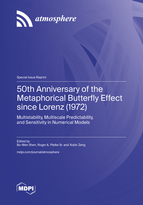50th Anniversary of the Metaphorical Butterfly Effect since Lorenz (1972): Multistability, Multiscale Predictability, and Sensitivity in Numerical Models
A special issue of Atmosphere (ISSN 2073-4433). This special issue belongs to the section "Meteorology".
Deadline for manuscript submissions: closed (28 February 2023) | Viewed by 32998
Special Issue Editors
Interests: global hurricane modeling and multiscale modeling; chaos and predictability; multiscale analysis; high performance computing and visualizations
Interests: land–atmosphere interactions; ocean–atmosphere interactions; climate system dynamics; nonlinear mathematical study of atmospheric and climate processes; large eddy simulation (LES) modeling; mesoscale modeling
Interests: land-atmosphere-ocean interface processes; weather and climate modeling; hydrometeorology; remote sensing; nonlinear dynamics; big data analytics
Special Issue Information
Dear Colleagues,
A well-accepted definition of the butterfly effect is the sensitive dependence on initial conditions (SDIC) that was rediscovered by Lorenz in 1963 (Lorenz 1963). Usage of the term “butterfly” appeared in 1972 when Lorenz applied a metaphor to discuss the possibility of whether a tiny perturbation may eventually create a tornado with a three-dimensional organized coherent structure. Since 1972, the metaphorical butterfly effect has received increasing attention, but its exact relation with the original butterfly effect (i.e., SDIC) has also become controversial. Lorenz (1963, 1972) laid a foundation for chaos theory, which is viewed as the 3rd scientific achievement of the 20th century, after relativity and quantum mechanics. The metaphorical butterfly effect turns 50 next year.
During the presentation announcing the 2021 Nobel Prize in Physics, the pioneering chaos study by Lorenz (1963) was cited as a foundation for the awarded studies. The awarded studies proposed physics-based mathematical models that are capable of revealing fundamental, crucial physical processes, including coexisting rapidly and slowly varying systems and the metastability of spin glass, in order to improve our understanding of predictability in complex systems such as weather and climate that possess time-varying multistability with coexisting attractors. At a smaller scale, as published by the Bulletin of the American Meteorological Society in January 2021, Shen et al. (2021) applied the generalized Lorenz model (Shen 2019) to propose a revised view that “weather possesses chaos and order; it includes emerging organized systems (such as tornadoes) and recurrent seasons”, in contrast to the conventional view of “weather is chaotic”.
In celebrating the 50th anniversary of the metaphorical butterfly effect in 2022, this Special Issue calls for research and review articles that report improved understanding for original and metaphorical butterfly effects, as well as recent advances in idealized Lorenz models and real-world models that address multistability, multiscale predictability, and sensitivity. Potential topics include (but are not limited to) the following:
- The validity of existing analogies and metaphors for butterfly effects.
- Insightful analyses of various Lorenz models (e.g., Lorenz 1963, 1969, 1984, 1996/2005) for revealing the role of monostability with single types of solutions and multistability with attractor coexistence in contributing to the multiscale predictability of weather and climate.
- The development of conceptual, theoretical, and real-world models for revealing fundamental physical processes and their multiscale interactions that contribute to the predictability of weather and climate.
- Innovative machine-learning methods that (1) classify chaotic and non-chaotic processes and identify weather and climate systems at various spatial and temporal scales (e.g., sub-seasonal to seasonal time scales), and (2) detect computational chaos and saturation dependence on various types of solutions.
- The impact of tiny perturbations on emergent pattern formation with self-organization (e.g., stripes and rolls), the formation of high-impact weather (e.g., tornadoes and hurricanes), etc.
References
- Shen, B.-W., R. A. Pielke Sr., X. Zeng, J.-J. Baik, S. Faghih-Naini#, J. Cui#, and R. Atlas, Is Weather Chaotic? Coexistence of Chaos and Order within a Generalized Lorenz Model. Bulletin of the American Meteorological Society, 102(1), E148-E158. Retrieved Jan 29, 2021a, Available online: https://journals.ametsoc.org/view/journals/bams/102/1/BAMS-D-19-0165.1.xml
- Shen, B.-W., Aggregated Negative Feedback in a Generalized Lorenz Model. International Journal of Bifurcation and Chaos: World Scientific, Singapore, Vol. 29, No. 3, 2019. https://doi.org/10.1142/S0218127419500378
- Shen, B.-W., R. A. Pielke Sr., X. Zeng, J.-J. Baik, S. Faghih-Naini, J. Cui, R. Atlas, T.A. Reyes: Is Weather Chaotic? Coexisting Chaotic and Non-Chaotic Attractors within Lorenz Models. In: Christos H. Skiadas, Yiannis Dimotikalis (eds) The 13th Chaos International Conference CHAOS 2020. Springer Proceedings in Complexity. Springer, Cham. 2021b. https://doi.org/10.1007/978-3-030-70795-8_57
Dr. Bo-Wen Shen
Prof. Dr. Roger Pielke Sr.
Prof. Dr. Xubin Zeng
Guest Editors
Manuscript Submission Information
Manuscripts should be submitted online at www.mdpi.com by registering and logging in to this website. Once you are registered, click here to go to the submission form. Manuscripts can be submitted until the deadline. All submissions that pass pre-check are peer-reviewed. Accepted papers will be published continuously in the journal (as soon as accepted) and will be listed together on the special issue website. Research articles, review articles as well as short communications are invited. For planned papers, a title and short abstract (about 100 words) can be sent to the Editorial Office for announcement on this website.
Submitted manuscripts should not have been published previously, nor be under consideration for publication elsewhere (except conference proceedings papers). All manuscripts are thoroughly refereed through a single-blind peer-review process. A guide for authors and other relevant information for submission of manuscripts is available on the Instructions for Authors page. Atmosphere is an international peer-reviewed open access monthly journal published by MDPI.
Please visit the Instructions for Authors page before submitting a manuscript. The Article Processing Charge (APC) for publication in this open access journal is 2400 CHF (Swiss Francs). Submitted papers should be well formatted and use good English. Authors may use MDPI's English editing service prior to publication or during author revisions.
Keywords
- butterfly effect
- sensitive dependence on initial conditions
- attractor coexistence
- chaos and order
- computational chaos
- Lorenz model
- predictability
- monostability
- multistability
- machine learning








